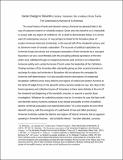Social change in eleventh-century Armenia : the evidence from Tarōn
Abstract
Although the Byzantine annexation of Armenian territories in the later tenth and eleventh centuries has been studied from a number of perspectives, little attention has been paid to the subsequent history of those districts, and in particular the circumstances and the responses of the communities who stayed put. This chapter explores the social and cultural history of the district of Tarōn in the century after its incorporation as a theme. Through comparison with the annexation of Vaspurakan in 1021, it argues that both the lay and clerical elite left Tarōn in 966. This affected land tenure in several ways, including the creation of stratiotika ktemata and the imposition of the demosion. Evidence from an Armenian Gospels manuscript indicates that the land tax was still being collected—and the registers updated—as late as 1067. A new network of episcopal sees was established across the former Armenian see of Tarōn. Finally the History of Tarōn, a composition completed in the 980s, shows how one monastic community took advantage of the recent turmoil to promote its claim to foundation and endowment by St Grigor the Illuminator at the start of the fourth century. It also forged multiple links between the activities of St Grigor and the metropolitan see of Caesarea, associating the conversion of Tarōn, and by implication of Armenia, with the Byzantine Church.
Citation
Greenwood , T 2020 , Social change in eleventh-century Armenia : the evidence from Tarōn . in J Howard-Johnston (ed.) , Social Change in Town and Country in Eleventh-Century Byzantium . Oxford studies in Byzantium , Oxford University Press , Oxford , pp. 196-219 . https://doi.org/10.1093/oso/9780198841616.003.0009
Publication
Social Change in Town and Country in Eleventh-Century Byzantium
Type
Book item
Collections
Items in the St Andrews Research Repository are protected by copyright, with all rights reserved, unless otherwise indicated.

